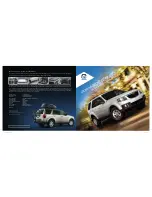
DO-IT-YOURSELF MAINTENANCE
6-12
the instruments to check it with a force of 22 lb.
(98N), the deflection should be approx. 0.197 ~
0.217 inches (5 ~ 5.5 mm). If the belt is too
loose, have it adjusted by your Hyundai dealer.
ZG140C1-E
Checking the Refrigerant
1. Start the engine and let it run at fast idle for
several minutes with the air conditioner set
at one of its colder settings.
2. Open the hood and check two hoses by
touching with your fingers. One line is the
evaporator inlet, the other is the outlet. If
there is a temperature difference between
the two hoses, the refrigerant is low and the
system should be recharged by your Hyundai
dealer.
CAUTION:
Running the air conditioning system for ex-
tended periods of time with a low refrigerant
level may damage the compressor.
ZG140D1-A
Lubrication
To lubricate the compressor and the seals in
the system, the air conditioner should be run for
at least 10 minutes each week. This is particu-
larly important during cool weather when the air
conditioning system is not otherwise in use.
G140A01A-AAT
AIR CONDITIONING CARE
Keeping the Condenser Clean
The air conditioning condenser (and engine
radiator) should be checked periodically for
accumulation of dirt, dead insects, leaves, etc.
These can interfere with maximum cooling effi-
ciency. When removing such accumulations,
brush or hose them away carefully to avoid
bending the cooling fans.
G140D01X-EAT
Checking the Compressor Drive Belt
G140D01X
A/C pulley
0.197 ~ 0.217 in. (5 ~ 5.5 mm)
Crank pulley
When the air conditioning is being used regular-
ly, the compressor drive belt tension should be
checked at least once a month.
To check the drive belt tension, press down on
the belt halfway between the engine crankshaft
and compressor pulleys. Pressing with your
finger, you should not be able to deflect this belt
anymore than 0.197 ~ 0.217 inches. If you have
G120E01X-DAG
G120E02A-AAT
Adding Brake Fluid
WARNING:
Handle brake fluid carefully. It can damage
your vision if it gets into your eyes. Use only
DOT 3 or DOT 4 specification fluid from a
sealed container. Do not allow the fluid can
or reservoir to remain open any longer than
required. This will avoid entry of dirt and
moisture which can damage the brake sys-
tem and cause improper operation.
To add brake fluid, first wipe away any dirt then
unscrew the fluid reservoir cap. Slowly pour the
recommended fluid into the reservoir. Do not
overfill. Carefully replace the cap on the reser-
voir and tighten.
















































